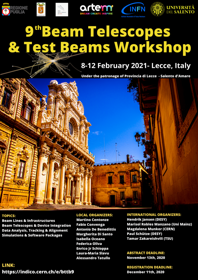Speaker
Description
The IPHC (Institut Pluridisciplinaire Hubert Curien) has installed a specific beam line for tests and irradiation of detectors with the 25 MeV proton beam of the cyclotron CYRCé. Beam intensities range from 1 fA to maximal 100 nA. The Cyclotron delivers a pulsed beam with a frequency of 85 MHz, which can be divided at the source by an oscillating electrostatic field of 21.25MHz down to 42.5 MHz and will allow combined detector and electronics operation at frequencies close to the LHC. An experimental setup has been developed to carry out detector and irradiation tests. The setup consists of a thin beam scintillator for triggering, a mechanical X-Y positioner for the DUT (Detector Under Test) and two reference planes of CMS-Pixel detectors. Because the air could possibly be activated at higher beam intensities, an extraction system creates a small under-pressure of 20 Pascal in the setup.
Four CMS Pixel modules have been used to built two reference planes in front and behind the detector under test (DUT), each plane consisting of two modules mounted side by side with a small overlap of about one millimetre. The pixel modules are read out by an intermediate board identical to the CMS beam telescope CHROMIE. The purpose of this telescope is to define tracks of individual protons and to determine the impact point with a spatial resolution in the order of the granularity of the DUT, approximately 100 microns, mainly limited by multiple scattering. In this talk we will describe the detector setup, the operation of the pixel modules, the electronic read-out, the trigger and synchronization system and the Data Acquisition Chain (DAQ) and we will present first test beam results of a full scale 2S CMS tracking detector. Further we will describe the opportunities in 2021 for outside users to irradiate and/or test Silicon detectors with or without cooling using the above experimental set-up
